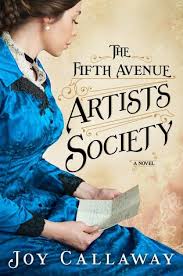Please Note: I received an ARC Copy of this book through Edelweiss in exchange for an honest review. This does not influence the opinions in my review in any way.
Synopsis (From GoodReads):
The Bronx, 1891. Virginia Loftin knows what she wants most: to become a celebrated novelist despite her gender, and to marry Charlie, her best friend, neighbor and first love. Yet when Charlie proposes to another woman, Ginny is devastated; shutting out her family, she holes up and obsessively rewrites how their story should have gone.Though Ginny works with newfound intensity, success eludes her—until she attends a salon hosted in her brother’s handsome author friend John’s Fifth Avenue mansion. Amongst painters, musicians, actors, and writers, Ginny returns to herself, even blooming under John’s increasingly romantic attentions. Just as she has begun to forget Charlie, however, he throws himself back into her path, and Ginny finds herself torn between a lifetime’s worth of complicated feelings and a budding relationship with a man who seems almost too good to be true.
The brightest lights cast the darkest shadows, and as Ginny tentatively navigates the Society’s world, she begins to suspect all is not as it seems in New York’s dazzling “Gay Nineties” scene. When a close friend is found dead in John’s mansion, Ginny must delve into her beloved salon’s secrets to discover her true feelings about art, family, and love.
Review:
Historical Fiction is my favorite genre. Reading it can transport me to a time and place I cannot possibly experience anyplace other than books. When I saw the description and beautiful cover for The Fifth Avenue Artists Society, by Joy Callaway, I jumped and requested it from Edelweiss (my first approval from them!). I have very mixed feelings about this book. There were things I loved about it, but also I felt there were flaws that made it seem inauthentic.What I Liked
I did enjoy the setting of 1890's New York. I thought that the author did a wonderful job of showing the hustle and bustle of the city and the varying degrees of living standards. While some people were enormously wealthy, others were freezing and starving just blocks away. I think it must have been terrible to be one of the "have nots" in this world. One could easily see the luxury some people had, and yet you might be struggling to have enough food for your children.The author also showed the immense disparity between men and women of that time. The main character is a budding author but is rejected time and time again because she is a woman. Her sister faces similar discrimination as a musician. She cannot join an orchestra due to her gender, even though she plays better than the men. When Ginny finds the Fifth Avenue Artists Society, a Friday evening gathering of male and female artists, she feels like has gone to heaven. Men and Women did not usually mingle so freely, plus men often regarded women's artistic endeavors as inferior. But at these gatherings, Ginny feels respected and thrives.
What I Didn't Like:
The book is based on the author's ancestors. This is important to note because I think this is why most of the characters are not allowed to have any real faults. The author soft-peddles their flaws to the point that everyone has a good heart, even if they have done despicable things. Ginny, the main character, is hurting from being blind-sided with her childhood sweetheart marrying a different (and wealthy) girl. Yet, she still seems to love him. Her brother, Franklin, also makes some very bad choices, but since he would never intentionally hurt someone, all is forgiven. Ginny even gets mad at her family members when they become angry with Franklin. Although Franklin goes through a lot of difficulties, I thought he (and others) just weren't allowed to be actually bad people.I also thought Ginny continuing to love Charlie was problematic. Charlie visits Ginny and (and kisses her on the street in full view of the neighbors) despite being married. This would have caused a scandal in 1892. But there are no consequences for their open affection of each other. Also Ginny doesn't seem to feel bad that she is interfering in Charlie's marriage. I was waiting for a juicy confrontation between Ginny and Charlie's wife, Rachel. It would have been much more realistic if Rachel paid Ginny a little visit and told her to stay away from her husband. This would have given Ginny reason to pause and consider the implications of what she was doing.
There were also several scenes where Ginny is getting very physical with men. She doesn't seem to feel any Victorian guilt or worry that she is being intimate without a ring on her finger. I thought this was out of place for the time period. Even if Ginny didn't feel guilty, there should have been some explanation in the book about her being a free spirit, or something else to account for her behavior.
While I liked the setting and the story of struggling artistic sisters, I just felt that this book could have used more authentic personal dilemmas and been more honest about the darker side of the character's personalities.
Rating:
Release Date: May 31st, 2016
Source: Edelweiss
Format: ARC E-Book
Recommendation: I think if you love historical fiction, you will like it well enough. But I would wait for it to come out in paperback or get it from the library.

































Great review. I might as well read this. i want to explore more about Historical Fiction. :)
ReplyDelete#Commenting365
- Christine @ Tine's Reviews
Too bad, it sounded so promising!
ReplyDelete